Spanish
A lo largo de mi primer mes en la Habana, los habaneros iban diciéndome que la ciudad no es una buena representación de Cuba como un país. Decían que para experimentar la ‘Cuba real’, yo necesitaba ir al campo; allá, donde los bueyes siguen siendo más populares como herramientas agriculturas que los tractores, vería yo una Cuba más sencilla, más característica del país entero.
Por lo tanto, unas amigas y yo escogimos Viñales como nuestro destino, un pueblito al lado de un valle con las vistas más hermosas de Cuba (al menos, según la guía de Lonely Planet). De veras, el Valle de Viñales contiene sitios reconocidos por UNESCO como Patrimonios de La Humanidad, además de fincas de tabaco y café.
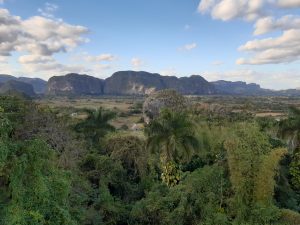
Cuando organizamos un fin de semana para irnos de la ciudad, la Habana fue todo que conocíamos de Cuba: edificios concretos desmoronando; calles vivas con música y voces; carros soviéticos espumando gases tóxicos; y la casi omnipresencia del ron. Cogimos la oportunidad de liberarnos los pulmones de la polución habanera y escaparnos de la ciudad – y conocer más del país.
En el viernes, tomamos la primera guagua que pudimos, a las 8:40. Como íbamos oeste, más y más lejos del centro de la ciudad, lo urbano se convertía gradualmente en un lo agrícola. Infinitas viviendas grises llegaron a ser llanura, rasa y verde; ya no eran los rascacielos que bloqueaban el horizonte, sino las colinas, suavemente onduladas. Dentro de poco, estábamos envueltos por el campo. No vimos ningún signo de la urbanidad hasta volver a la Habana en el domingo.
Viñales todavía resembla un vestigio de una época ya en el pasado. Para hacer viajes por las calles y entre las fincas locales, los campesinos o montan los caballos o se sientan en carretas que éstos remolcan. Además, si visitas Viñales no verás maquinaria agrícola sofisticada, a pesar de las millas de tierra cultivada; es más probable que ojees, como nosotros en un sendero antes del amanecer, un arado tradicional esperando un par de bueyes.
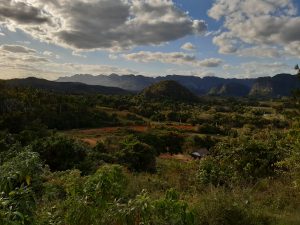
Sin embargo, en Viñales no se debe confundir lo tradicional con lo obsoleto: es el estilo de vida antiguo que ha hecho posible la transformación del pueblo en un sitio sumamente popular con los turistas. Pese al influjo extranjero, existe una gran cordialidad entre los nativos y los turistas en Viñales. Observar los beneficios de esta relación simbiótica es fácil: la calidad de las viviendas es muy alta, que no debe sorprenderse dado que la mayoría son casas particulares. Por alrededor de $25 por noche, los turistas pueden obtener alojamiento barato con una familia local, mientras que la familia consigue una subsistencia mucha más alta que la pagada por el estado (el sueldo estatal cubano es $30 por mes). Así es que mucho del pueblo gana un sueldo de los turistas y los trata con mucha cortesía.
Sobre todo, lo que me impresionaron más de Viñales fueron los productos agrícolas. Comimos afuera en tres restaurantes durante nuestra estancia y cada uno obtenía sus ingredientes de una finca conectada con la empresa. (En una ocasión, el restaurante era, de hecho, una finquita. Comimos con una vista del sol descendiendo detrás de las montañas, la luz crepuscular dejando el paisaje por la frazada de la noche.) Como resultado, toda la comida fue completamente fresca y altamente rica.
Además de la comida, explorábamos unos productos más típicamente asociados con el país. Montados en caballos, fuimos entre las fincas de tabaco y café, probando todo lo que nos estaba disponible. La producción del café me fascina, pero esta conocía más o menos bien; por otro lado, la el cultivo tabaquero todavía me seguía teniendo algo de misterioso, y fue por esta razón que Viñales había sido para mí un sitio de alto interés aún antes de venir a Cuba. Pero, como explicaré, ahora el misterio me ha resuelto.
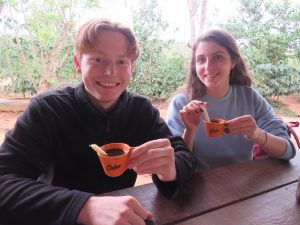
Trying the local coffee where it is grown. Sugar cane (which you suck on to release the sugar) is used instead of sugar grains to sweeten the coffee.
Mientras que la finca que visitamos debe vender un 90% de su rédito tabaquero al estado, conserva el último 10% con lo cual hace cigarros ‘puros’ (es decir, sin químicos artificiales) que se vende localmente. Después de que cosechen las hojas de tabaco, las transportan a una choza donde se secan durante seis meses. Al recoger las hojas secas, las vaporizan con un líquido que contiene, entre otras cosas, el agua, la miel, y la “Vitamina R” (esto es como se llama el ron en Viñales). Las quitan la vena media, donde se concentra la nicotina durante el proceso de secamiento, y las cortan en rectángulos. Finalmente, enrollan las hojas rectangulares para crear el cigarro. Pero, queda una etapa vital: fumarlo. Para hacer eso se añade miel – la cual actúa como un filtro natural, como señalaba el gran Che –, se enciende, se da caladas, y se conserva el humo entre las mejillas hasta apreciar bien el sabor natural del tabaco, libre las químicas.
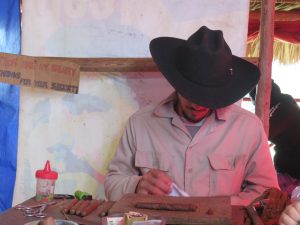
Local tobacco farmer teaches us how to make a cigar (and smoke it).
Después de unas caminatas debajo de los mogotes maravillosos, nuestra estancia en Viñales llegó a su fin y volvimos a la Habana en nuestra guagua Víazul. Como esperábamos, verdaderamente vimos otro lado de Cuba, y yo voy a echar de menos mucho el aire limpio y la disponibilidad de buenos senderos en Viñales. Pero si hay una cosa que vincula ambos Viñales y la capital, es el turismo. A veces las atracciones turísticas pueden imponer mucha distancia entre los nativos y los extranjeros, pero mi viaje a Viñales me demostró como el turismo puede unir a estos grupos y a la vez producir grandes beneficios económicos para la población local.
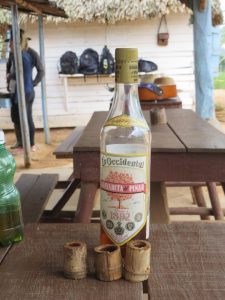
English
During the course of my first month in Havana, locals continued to tell me that the city was not a good representation of Cuba as a country. They said that in order to experience ‘the real Cuba’, I had to go to the countryside; there, where oxen are still more popular as agricultural tools than tractors, I would see a simpler Cuba, more characteristic of the country as a whole.
So, some friends and I chose Viñales as our destination, a small town next to a valley with the most beautiful views in Cuba (at least according to the Lonely Planet guidebook). Indeed, as well as containing tobacco and coffee farms, parts of the Valley of Viñales are recognised by UNESCO as World Heritage sites.
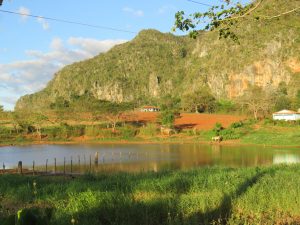
At the time of organising a weekend to leave the city, Havana was all that we knew of Cuba: crumbling concrete buildings; streets alive with voices and music; Soviet cars puffing out toxic fumes; and the near omnipresence of rum. We jumped at the opportunity to free our lungs of the Havana pollution and escape from the city – and see more of the country.
On the Friday, we took the first bus that we could, at 8:40. As we headed west, further and further away from the city centre, urbanity gradually became countryside. Endless grey housing became prairie, flat and green; no longer was it skyscrapers that blocked the horizon, but gently rolling hills. Before long, we were surrounded by the countryside. We did not see another sign of urbanity until returning to Havana on the Sunday.
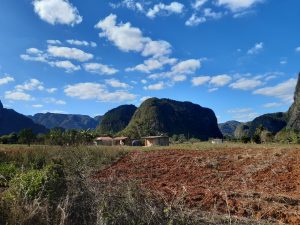
Viñales still seems like the relic of a past era. To travel through the streets and between the local farms, farmers either ride on horseback or sit in horse-drawn carts. Furthermore, if you visit Viñales, you will not see sophisticated agricultural machinery, despite the miles of cultivated land; it is more likely that, like us on a pre-dawn hike, you will catch a glimpse of a traditional plough awaiting a pair of oxen.
However, in Viñales, the traditional must not be confused with the obsolete; it is the olden lifestyle that has made possible the transformation of the town into a place extremely popular with tourists. Despite the influx of foreigners, there is a great cordiality between locals and tourists in Viñales. It is easy to see the benefits of this symbiotic relationship: for around $25 per night, tourists can obtain cheap accommodation with a local family, whilst the family earns a living that is far greater than the state salary (the Cuban state pays a salary of $30 a month). As such, much of the town earns a living from tourists and so they treat them very well.
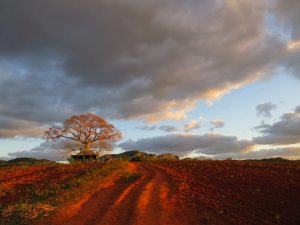
Above all, what impressed me most about Viñales was the local produce. We ate in three restaurants during our stay and each one obtained its ingredients from a farm connected to the business. (On one occasion, the restaurant was itself a small farm. We ate with a view of the sun descending behind the mountains, the light of dusk leaving the landscape for the blanket of night.) As a result, all of the food was completely fresh and extremely tasty.
In addition to the food, we explored some products more typically associated with the country. On horseback, we went between tabaco and coffee plantations, trying everything that was available to us. Coffee production fascinates me, but I was more or less familiar with the process; on the other hand, tobacco cultivation still remained something of a mystery to me, and it was for that reason that Viñales had interested me even before I came to Cuba. But, as I shall explain, the mystery has now been solved.
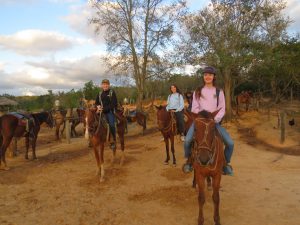
Exploring the farms on horseback.
Whilst the farm we visited is obliged to sell 90% of its tobacco yield to the state, it keeps the remaining 10%, with which it makes ‘pure’ cigars (that is, cigars without artificial chemicals), which it sells locally. After they harvest the tobacco leaves, they transport them to a hut where they are dried for six months. On collecting the dry leaves, they spray them with a mixture that contains, amongst other things, water, honey, and “Vitamin R” (this is what they like to call rum in Viñales). They remove the midrib from the leaves, where nicotine concentrates during the drying process, and they cut them into rectangles. Finally, they roll the rectangular leaves to create the cigar. However, there remains one more crucial step: smoking it. And in order to do this you must add honey – which acts as a natural filter, as the great Che used to say – light it, take a puff, and hold the smoke between your cheeks, appreciating the natural flavour of the chemical-free tobacco.
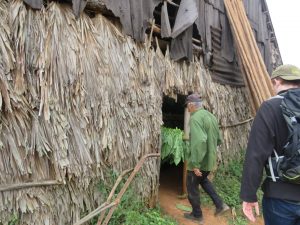
A hut where tobacco is dried.
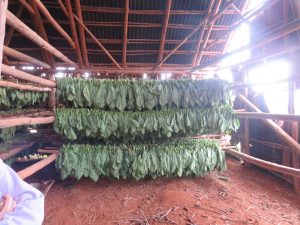
Tobacco, stored in a hut to dry for six months.
After a few walks below the spectacular limestone hills, our stay in Viñales came to an end and we returned to Havana on our Víazul bus. As we expected, we truly saw another side to Cuba, and I am going to sorely miss the clean air and availability of good hikes in Viñales. But if there is one thing that links both Viñales and the capital, it is tourism. Sometimes tourist attractions can impose a lot of distance between natives and foreigners, but my trip to Viñales showed me how tourism can bring these groups together and at the same time produce great economic benefits for the local population.
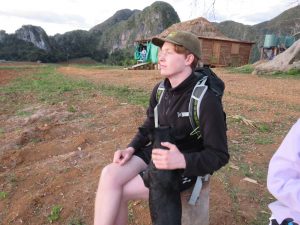 Mingling with a local friend on a pre-dawn hike.
Mingling with a local friend on a pre-dawn hike.
